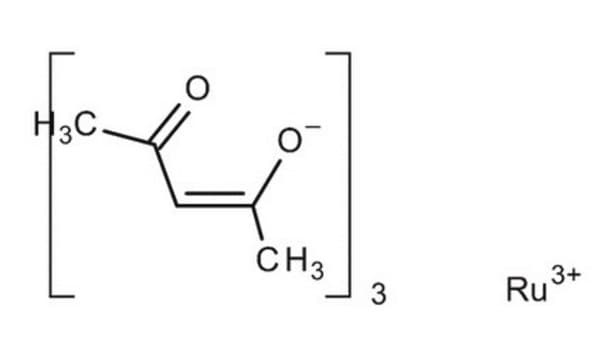208523
Ruthenium(III) chloride
Ru content 45-55%
Synonyme(s) :
Ruthenium trichloride
About This Item
Produits recommandés
Forme
solid
Pertinence de la réaction
core: ruthenium
reagent type: catalyst
reaction type: Atom Transfer Radical Polymerization (ATRP)
Densité
3.11 g/mL at 25 °C (lit.)
Chaîne SMILES
Cl[Ru](Cl)Cl
InChI
1S/3ClH.Ru/h3*1H;/q;;;+3/p-3
Clé InChI
YBCAZPLXEGKKFM-UHFFFAOYSA-K
Vous recherchez des produits similaires ? Visite Guide de comparaison des produits
Description générale
Application
- In the synthesis of β‐amino alcohols by nucleophilic opening of epoxides with anilines.
- In the acetylation of varies of phenols, alcohols, thiols, and amines under mild conditions.
- In the synthesis of α‐aminonitriles by mixing aldehydes, amines, and trimethylsilyl cyanides.
Autres remarques
Mention d'avertissement
Danger
Mentions de danger
Conseils de prudence
Classification des risques
Acute Tox. 4 Oral - Aquatic Chronic 2 - Eye Dam. 1 - Skin Corr. 1B
Code de la classe de stockage
8B - Non-combustible corrosive hazardous materials
Classe de danger pour l'eau (WGK)
WGK 3
Point d'éclair (°F)
Not applicable
Point d'éclair (°C)
Not applicable
Équipement de protection individuelle
Eyeshields, Faceshields, Gloves, type P3 (EN 143) respirator cartridges
Certificats d'analyse (COA)
Recherchez un Certificats d'analyse (COA) en saisissant le numéro de lot du produit. Les numéros de lot figurent sur l'étiquette du produit après les mots "Lot" ou "Batch".
Déjà en possession de ce produit ?
Retrouvez la documentation relative aux produits que vous avez récemment achetés dans la Bibliothèque de documents.
Les clients ont également consulté
Articles
Micro review of reversible addition/fragmentation chain transfer (RAFT) polymerization.
Protocoles
We present an article about RAFT, or Reversible Addition/Fragmentation Chain Transfer, which is a form of living radical polymerization.
We presents an article featuring procedures that describe polymerization of methyl methacrylate and vinyl acetate homopolymers and a block copolymer as performed by researchers at CSIRO.
Polymerization via ATRP procedures demonstrated by Prof. Dave Haddleton's research group at the University of Warwick.
Notre équipe de scientifiques dispose d'une expérience dans tous les secteurs de la recherche, notamment en sciences de la vie, science des matériaux, synthèse chimique, chromatographie, analyse et dans de nombreux autres domaines..
Contacter notre Service technique














